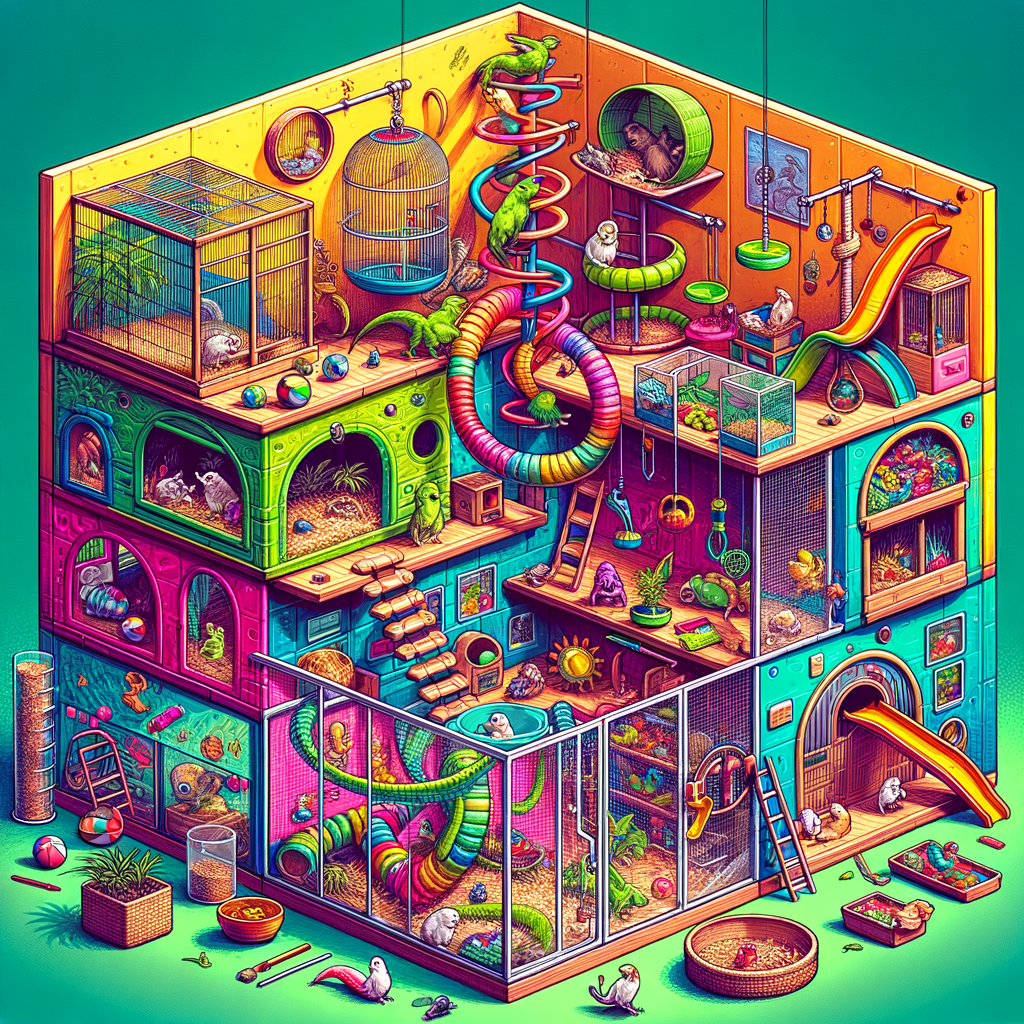
Introduction: Exotic Pet Care in Small Spaces
Exotic pets, with their unique and fascinating behaviors, can bring a touch of the wild into our homes. However, caring for these special creatures in small spaces can present unique challenges. This guide will provide you with the necessary knowledge and practical tips to ensure your exotic pet thrives, even in a small space.
- Understanding the Unique Needs of Exotic Pets
- Challenges and Solutions for Providing Enrichment in Small Spaces
Exotic pets, unlike common domestic animals like dogs and cats, have specific needs that must be met to ensure their health and happiness. These needs often stem from the conditions in their natural habitats. For example, a reptile may require a heat lamp to mimic the warmth of its tropical home, while a bird may need plenty of vertical space to fly and exercise. Understanding these unique needs is the first step in providing proper care for your exotic pet.
Providing enrichment for exotic pets in small spaces can be challenging. Enrichment refers to activities, objects, or environments that stimulate your pet and encourage natural behaviors. In small spaces, it can be difficult to provide the variety and complexity of enrichment that exotic pets need.
However, with creativity and planning, it’s possible to overcome these challenges. For instance, vertical space can be utilized for climbing pets like lizards or birds. Toys and activities can be rotated to keep your pet engaged without cluttering your space. Even simple changes, like rearranging your pet’s habitat, can provide new and exciting experiences for them.
As we delve deeper into the world of exotic pet care in small spaces, we will explore the natural habitats of different exotic pets, discuss indoor pet enrichment strategies, and address common concerns. By the end of this guide, you will be equipped with the knowledge and tools to embrace the joys of exotic pet ownership, no matter the size of your living space.
Understanding Your Exotic Pet’s Natural Habitat
When it comes to caring for exotic pets, understanding their natural habitat is crucial. This knowledge helps us create an environment that closely mimics their home in the wild, ensuring their health and happiness.
Exotic Pet Habitat: From Wild to Home
Exotic pets come from a variety of environments, each with its unique characteristics. By understanding these environments, we can provide our pets with a home that closely resembles their natural habitat, even in a small space.
- Case study: From jungle to apartment – a parrot’s journey
- Key takeaway: Importance of replicating natural habitats in small pet enclosures
Consider the case of a parrot. In the wild, parrots live in tropical rainforests, where they have plenty of space to fly and socialize with other parrots. In an apartment, we can replicate this environment by providing a large cage with plenty of toys for stimulation, and ensuring our parrot gets plenty of social interaction with us.
Replicating your pet’s natural habitat as closely as possible is crucial for their wellbeing. This can be achieved by providing the right type of enclosure, temperature, humidity, lighting, and diet. For example, reptiles need a heat source, while birds need plenty of light. By understanding and replicating these conditions, we can ensure our pets thrive in their new home.
Remember, each pet is unique and may have specific needs. Always do your research and consult with a vet or a pet care expert to ensure you’re providing the best care for your exotic pet.
Indoor Pet Enrichment: Making the Most of Your Space
Living in a small space doesn’t mean you can’t provide a rich and stimulating environment for your exotic pet. With a little creativity and understanding of your pet’s needs, you can turn any space into a pet paradise. Let’s explore some ideas for toys and activities that can enrich your pet’s life indoors.
Small Space Pet Ideas: Toys and Activities
When it comes to pet enrichment, toys and activities play a crucial role. They not only keep your pet entertained but also stimulate their natural instincts and behaviors. Here are some ideas for small space pet enrichment:
- Exotic pet toys: What works and what to avoid
- DIY pet enrichment: Creative ideas for small spaces
- Homemade Foraging Toys: Use safe, non-toxic materials to create toys that encourage your pet to ‘hunt’ for their food. This can be as simple as hiding treats inside a cardboard tube for a bird or a small mammal.
- Interactive Feeders: Turn mealtime into playtime by creating a homemade interactive feeder. This could be a puzzle toy for a dog or a hanging feeder for a bird.
- Hideouts: Create hideouts using cardboard boxes or safe, non-toxic plants. These can provide a sense of security for your pet and encourage natural behaviors like burrowing or climbing.
Choosing the right toys for your exotic pet can be a challenge. It’s essential to consider their natural behaviors and instincts. For instance, birds may enjoy toys that encourage foraging, while reptiles might prefer items that allow them to climb or hide. However, avoid toys with small parts that can be swallowed, or those made from toxic materials. Always ensure the toys are safe and suitable for your pet’s size and species.
You don’t need a lot of space or money to create an enriching environment for your pet. Here are some DIY ideas:
Remember, the key to successful pet enrichment is understanding your pet’s needs and behaviors. With a little creativity, you can create a stimulating and enriching environment for your pet, no matter how small your space might be.
Enrichment for Small Pets: Beyond Toys
When it comes to caring for small pets, there’s a lot more to consider than just providing them with toys. The environment in which your pet lives plays a significant role in their overall health and happiness. Let’s explore how you can create an enriching environment for your small pet.
Creating an Enriching Environment
Creating an enriching environment for your small pet goes beyond just providing them with toys. It’s about making their living space as comfortable, stimulating, and natural as possible. Here are some key points to consider:
- Importance of variety in your pet’s environment
- Examples of multi-use pet furniture for small spaces
Just like humans, pets also need variety in their lives to keep them mentally and physically stimulated. A varied environment can help prevent boredom and promote healthy behaviors. This can include different types of toys, various textures in their bedding, and even changing the layout of their habitat from time to time.
Multi-use pet furniture can be a great way to maximize space and provide enrichment for your pet. For example, a multi-level cage with ramps and hideaways can provide your pet with plenty of opportunities for climbing and exploring. Another example could be a piece of furniture that serves as both a sleeping area and a feeding station. These types of furniture not only save space but also provide your pet with a more stimulating environment.
In conclusion, creating an enriching environment for your small pet involves more than just providing them with toys. It’s about creating a space that caters to their natural behaviors and needs, and provides them with a variety of experiences. Remember, a happy pet is a healthy pet!
Addressing Common Concerns in Small Space Exotic Pet Care
Living with an exotic pet in a small space can be a rewarding experience, but it also comes with its unique set of challenges. In this section, we will address some of the most common concerns pet owners face, including noise, mess, and other issues that may arise.
Dealing with Noise, Mess, and Other Challenges
Exotic pets, like any other pets, can create noise and mess. However, these challenges can be managed effectively with the right approach. Let’s explore some practical solutions.
- How to manage noise levels in small spaces
- Provide your pet with plenty of stimulation to prevent boredom, which can lead to excessive noise.
- Set up a quiet zone in your living space where your pet can retreat to when they need some quiet time.
- Use soundproofing materials to minimize noise transmission.
- Keeping your small pet enclosure clean and odor-free
- Clean the enclosure regularly. Depending on your pet’s species, this could be daily, weekly, or monthly.
- Use pet-safe cleaning products to avoid harming your pet.
- Consider using odor-absorbing bedding material.
- Ensure proper ventilation in the enclosure to prevent the buildup of unpleasant smells.
Noise can be a significant concern, especially in small spaces. Some exotic pets, such as parrots or sugar gliders, can be quite vocal. To manage noise levels, consider the following tips:
Maintaining a clean and odor-free enclosure is essential for your pet’s health and your comfort. Here are some tips to help you achieve this:
By addressing these common concerns, you can ensure a comfortable and healthy environment for your exotic pet, even in a small space. Remember, every pet is unique, so it’s important to understand their specific needs and behaviors.
Conclusion: Embracing the Joys of Exotic Pet Ownership
As we draw our discussion to a close, it’s important to remember that owning an exotic pet can be a rewarding and fulfilling experience. However, it requires a significant amount of dedication, understanding, and care to ensure your pet’s happiness and health. Let’s reiterate some key points and share some final thoughts on creating a happy, healthy environment for your exotic pet.
- Reiterating the Importance of Enrichment for Small Pets
- Final Thoughts on Creating a Happy, Healthy Environment for Your Exotic Pet
Enrichment is not just about toys or playtime. It’s about providing a stimulating environment that mimics your pet’s natural habitat as closely as possible. This includes the right kind of food, adequate space to roam, and plenty of opportunities for mental stimulation. For example, a hamster might enjoy a wheel for exercise, while a chameleon would appreciate a variety of branches to climb on. Remember, a well-enriched environment can significantly improve your pet’s quality of life.
Creating a happy, healthy environment for your exotic pet is a labor of love. It involves understanding their unique needs, providing the right diet, and ensuring they have plenty of opportunities for physical and mental stimulation. Regular veterinary check-ups are also crucial to monitor their health. Remember, a happy pet is a healthy pet, and a healthy pet can bring immense joy and satisfaction.
In conclusion, owning an exotic pet is a journey filled with learning and growth. It’s about understanding and embracing their unique traits and needs, and providing the best possible care. So, let’s celebrate the joys of exotic pet ownership and strive to create a world where every pet, regardless of its species, can thrive and live a happy, healthy life.








